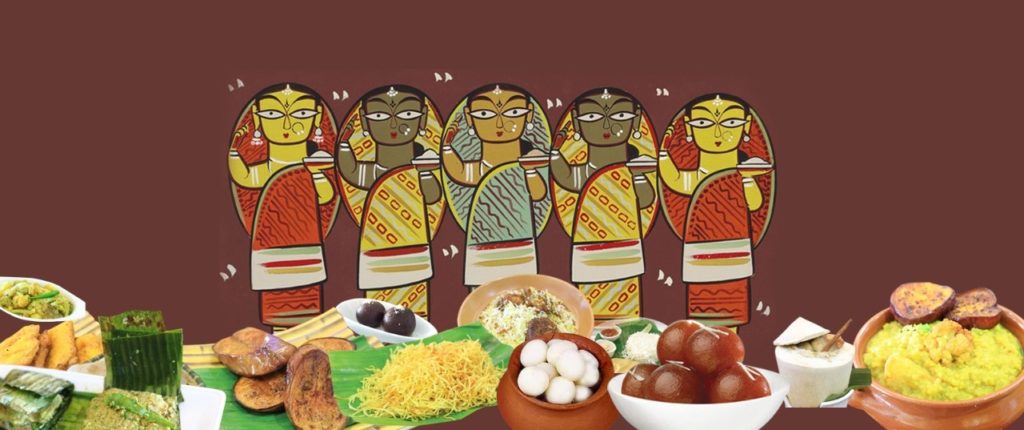
“What’s in a name?” Shakespeare asked this very eloquently in his 1597 epic – “Romeo and Juliet”. Little did he know that 7,000 miles East of London, in Calcutta, the “Bangalees” were scripting their own epic with the same theme; not in Literature, but in food.
The same extends to Bengali food. “Chorchori”, “Ghonto”, “Chhechki”, “Labra” and “Chhenchra” sound like swear words to people who have never heard of these dishes before. Even to some Bangalees, these do not sound like dishes one would heartily order at a restaurant, or even think of making at home. Essentially, all 5 dishes are vegetarian mish-mashes, each however is customized based on what the hero vegetable is, what base the gravy is, or even “What did ‘Thakuma’ want for lunch today?”

A smorgasbord of “Niramish” (Vegetarian) Bengali dishes with names that Shakespeare would be proud of[/caption]
Each dish has a character and an abundance of flavor that lights up dinners and the eaters’ faces. Only when you dig into a spoonful of “Labra” with “bhaat” or “Khichuri” will you truly experience the Umami that every Michelin Star chasing restaurant tries to create. The only problem is –the folks who’ve never experienced a “Labra” or a “Chhenchra” in their lives will never know what they’re missing out in their lives. It’s like being “blind-date-matched” with a “Padma Lakshmi” and leaving without meeting her because you assumed her to look like their “kakimas”. But us “Labra” eating folks know that supermodel-turned-UN-Goodwill-Ambassador Padma Lakshmi deserves better than that.
Each of the devastatingly named preparations in the Bengali cuisine has a story to tell, and a really tasty one at that. Some food research hints that these dishes date back to the 15th Century AD, with “Labra” being Chaitnyadev’sfavorite food to eat. If only we had a time machine to take us back to the serenity of the year 1486 maybe we could ask our “Chorchori” eating Bengali friends – why they named their lunch in a way that sounds like two slaps landing on an unassuming cheek. Or we could witness a gentle lady, exhausted from cooking on an open flame for hours for her family of 4, once called out to her son and exclaimed “Ai Bubla! Taratarikhete aye, naa hole, chechki’rjagayedutochorchorikhabi! Chhenchrarmotondariyethekishna, Ghontohoyejabi!” (O Sweet Child of Mine called “Bubla”. Hasten and come hither to eat. Else, I shall have to thrash you instead of feeding you Chechki. Doth not keep standing there like a “Chhenchra”, son. You risk becoming a “Ghonto”!)
And thus, from the embers of a cow-dung fueled fire pit, arose the dishes that are today weekend favorites, weekday necessities and Pujo delicacies.
Bengalis are known for their prowess in a multitude of fields – Music, dance, art, literature, science, academia, social reform, cinema, being able to balance their sweet intake by having more sweets, their fondness for the finer things in life, and an unhealthy obsession with Sourav Ganguly. Despite giving India her first Nobel Laureate in Rabi Thakur, Bengalis are not known for their ability to eloquently “name” things. Whether it be giving “daaknaams” to their kids or naming their favorite foods, the Bengali nomenclature evokes guffaws from every Indian. NilanjanaLahiri – better known as “Jhumpa” (yes, Nilanjana became Jhumpa, and she wore it proudly) – immortalized this in her 2003 novel “The Namesake”. Bengalis may have laughable – and sometimes downright embarrassing – nicknames, but it’s what’s inside them – integrity, passion, intelligence and an insatiable appetite to be the best in their fields – that makes a “Gogol”, a “Bubla”, a “Khokon”, a “Potla” and even a “Ghontu” or “Bhontu” be a 100 times better than their regally named counterparts from around the world.
So when Shakespeare did ask “What’s in a name?” he was talking about not placing too much importance on the title itself and savoring the entity for what it is made of. I have a sneaky feeling that he was fed some “Chhechki” that evening by a mother who wouldn’t take no for an answer.
For Order : https://www.fifthseason.com.sg/Order/FifthSeason
For More details Visit : https://www.kolkatabeckons.com.sg/

